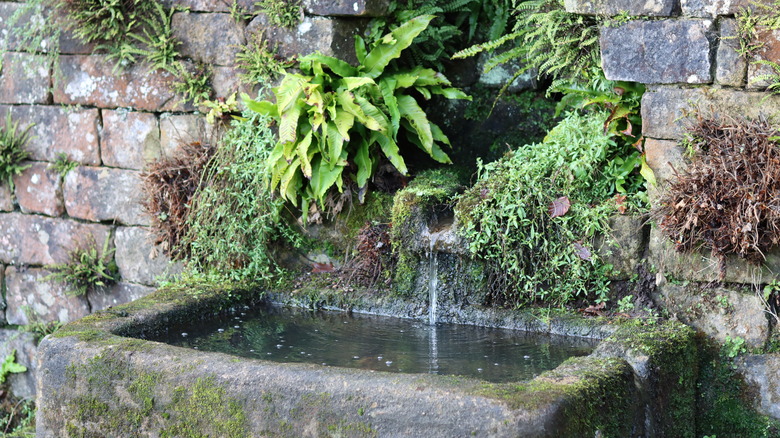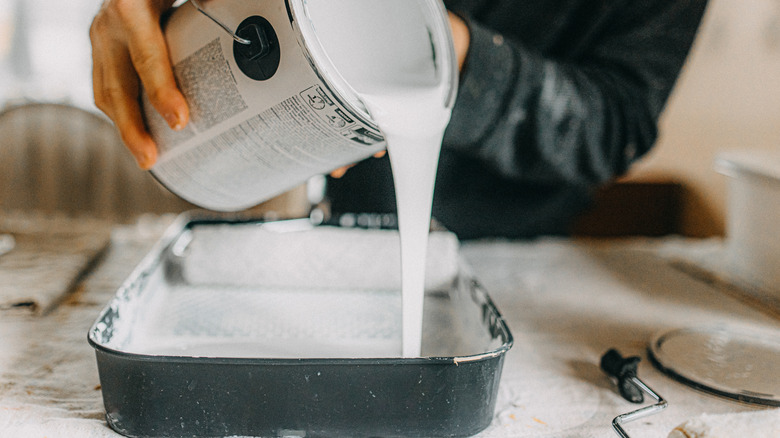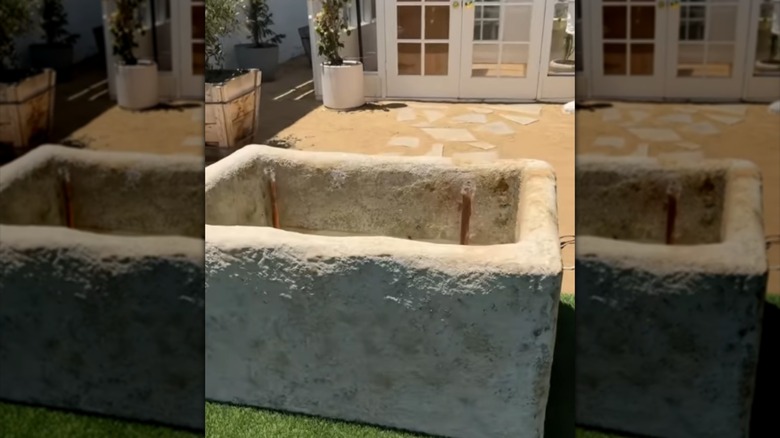Build A Budget-Friendly Faux French Travertine Fountain For Your Garden
If you're looking to bring some old-world style and charm to your home, add privacy, and drown out noise, a French travertine fountain can be the perfect addition. Unfortunately, even small fountains can cost thousands of dollars, with larger ones costing well over $10,000. These fountains are traditionally carved out of limestone by French artisans, but you can mimic the look for much less. The fastest way to get the look is by buying a stone trough and retrofitting it to create a fountain. If you happen to stumble across a reasonably priced stone trough and have the means to bring it home, this is a great option.
However, a stone trough is the kind of item that could sit on your thrift store BOLO list for years. While you're waiting, you can use hypertufa to DIY a faux limestone fountain starting this weekend. Hypertufa is a simulated stone mixture made from cement, perlite, and coconut fiber. It's durable but much lighter and cheaper than stone. To make a trough-like travertine fountain, you'll need two bins, one slightly larger than the other. Make the hypertufa by mixing 3 parts perlite, 3 parts coconut fiber, and 2 parts Portland cement. You can mix it in a wheelbarrow to make the process easier. Add water a little at a time until the mixture holds together when pressed with your hands.
Line the larger bin with plastic and spray it with cooking oil to make the fountain easy to remove. Add a base layer of the hypertufa to the bottom and sides of the large bin until it's about four or five inches thick. Put a piece of 3/4-inch PVC pipe where you want the pump hose to enter the fountain. Then cover your smaller bin with plastic and put it on top so the hypertufa is sandwiched between them. Add additional hypertufa to fill the space between the bins. Cover the top with plastic and let it sit for two days.
Finishing the hypertufa limestone
After 48 hours, remove the inner bin and turn the outer bin upside down to remove the fountain. Use a drill and a wire brush attachment to rough up the surface of the fountain before it fully cures. This will give you that aged patina of limestone that's hundreds of years old. Mist the fountain with water, cover it with plastic, and forget about it for two weeks. After two weeks, remove the plastic and let it dry out in a covered area, such as a garage, for several more days.
Now you can finish it with a lime wash. You can get a lime wash effect by diluting any off-white colored paint, but making the real thing is cheap, easy, and will give you the most authentic-looking results. It's also the most environmentally friendly option. However, limewash fades over time, so you may have to repaint it in a few years. Buy hydrated lime from the hardware store and mix it with water in a 1:4 ratio or until the mixture has the consistency of cream. Wear a mask, eye protection, gloves, and old clothes because lime is caustic and messy.
Brush the mixture all over the inside and outside of your fountain. Don't be too precious; it's fine if it's thicker in some areas than others. Let it dry and rough up the outside again with a wire brush if it's looking too perfect. Paint the inside with Flex Seal to prevent any leaks.
Adding the pump and spouts
Create the fountain spout element using copper pipes. Measure the length of your hypertufa pot. Your fountain should fit in the pot and leave enough room for a pump. For a smaller pot, you can keep it simple by placing one copper pipe over the pump tubing and calling it a day. For a more elaborate look, you can build a three-spout element. If you've ever reused old PVC pipes in your backyard, you understand the basic concept. Your hardware store should have copper pipe and fittings.
For a three-spout element, cut the base piece that will run along the bottom into four sections. Put a T-joint at each connection and put a copper pipe sticking up at each of the three T-joints. Stabilize it by adding a T-joint to each end of the bottom piece and adding small sections of pipe on each side to create a cross support. When you're finished, you'll have a freestanding element with a copper pipe horizontally on the bottom and three copper pipes standing vertically. After you've dry-fitted the pipes and tested the size, make it waterproof by using liquid solder to connect all of the pieces permanently.
Attach plastic tubing to each end of the fountain element and add a plastic T-joint in the middle. This will keep the water pressure even in all three spouts. Connect the T-joint to the pump, add a 3/4-inch fountain stopper plug, and fill your fountain.


